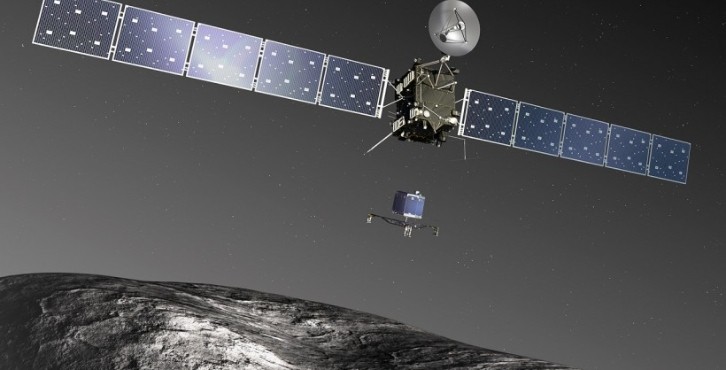In case you missed those news that actually matter, we’ll remind you that the iconic mission started by the European Space Agency named Rosetta is six days away from its final turning point: landing on a comet. It took 10 years and a journey of more than six billion kilometers (3.7 billion miles) and now humanity is literally days away from witnessing its first landing onto the surface of this mysterious cosmic iceberg.
If the mission is successful scientists believe it could change everything.
The adventure started in March 2004, when an European Ariane 5 rocket lifted off from Kourou in French Guiana. During its circuitous ten-year trek across the Solar System, Rosetta crossed the asteroid belt and traveled into deep space, more than five times Earth’s distance from the Sun. Its destination was a periodic comet known as Comet 67P/Churyumov-Gerasimenko.
Scientists around the world have worked together at this ground-braking space mission for years. They believe that, if successful, it could be key to unlocking answers about the formation of the Solar System, the origins of water on Planet Earth and perhaps even life itself.
According to the team’s plans, the Philae lander will be pushed away by Rosetta, which will be about 22.5 km (13.7 mi) from the comet’s centre.
In case the lander safely reaches the comet, it will then anchor itself into the surface. One our later, the first sequence of surface science experiments will begin, and will last for about 60 hours.
Reports are the orbiter will continue to study the comet using its 11 science instruments - but will also be relaying data from Philae’s instruments. The small spacecraft is designed with drills, ovens, cameras and sensors that will all analyze everything from the surface composition and temperature to the presence of amino acids - essential building blocks in the chemistry of life.
In case you want to get more intel about the whole space mission you can check out its website and also the video below.
The adventure started in March 2004, when an European Ariane 5 rocket lifted off from Kourou in French Guiana. During its circuitous ten-year trek across the Solar System, Rosetta crossed the asteroid belt and traveled into deep space, more than five times Earth’s distance from the Sun. Its destination was a periodic comet known as Comet 67P/Churyumov-Gerasimenko.
The landing is set for November 12
The orbiter has been in the proximity of the icy nucleus and the final turning point will represent the moment when a small lander will be released onto its surface. The spacecraft will launch its fridge-sized Philae lander on November 12, a procedure that should take about seven hours.Scientists around the world have worked together at this ground-braking space mission for years. They believe that, if successful, it could be key to unlocking answers about the formation of the Solar System, the origins of water on Planet Earth and perhaps even life itself.
According to the team’s plans, the Philae lander will be pushed away by Rosetta, which will be about 22.5 km (13.7 mi) from the comet’s centre.
It takes more than 28 minutes for the signal to reach Rosetta from Earth
Problem is everything needs to be extremely accurate for the little craft to land properly, which won’t be quite easy to do considering the event is taking place 510 million km (316 million miles) from Earth. Communication between Rosetta and controllers takes 28 minutes and 20 seconds each way.In case the lander safely reaches the comet, it will then anchor itself into the surface. One our later, the first sequence of surface science experiments will begin, and will last for about 60 hours.
Reports are the orbiter will continue to study the comet using its 11 science instruments - but will also be relaying data from Philae’s instruments. The small spacecraft is designed with drills, ovens, cameras and sensors that will all analyze everything from the surface composition and temperature to the presence of amino acids - essential building blocks in the chemistry of life.
In case you want to get more intel about the whole space mission you can check out its website and also the video below.
